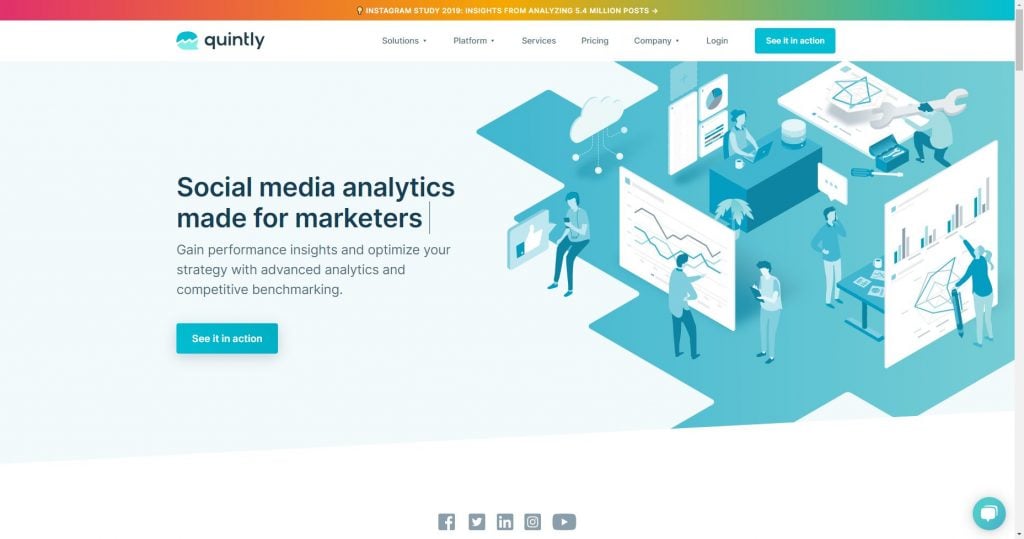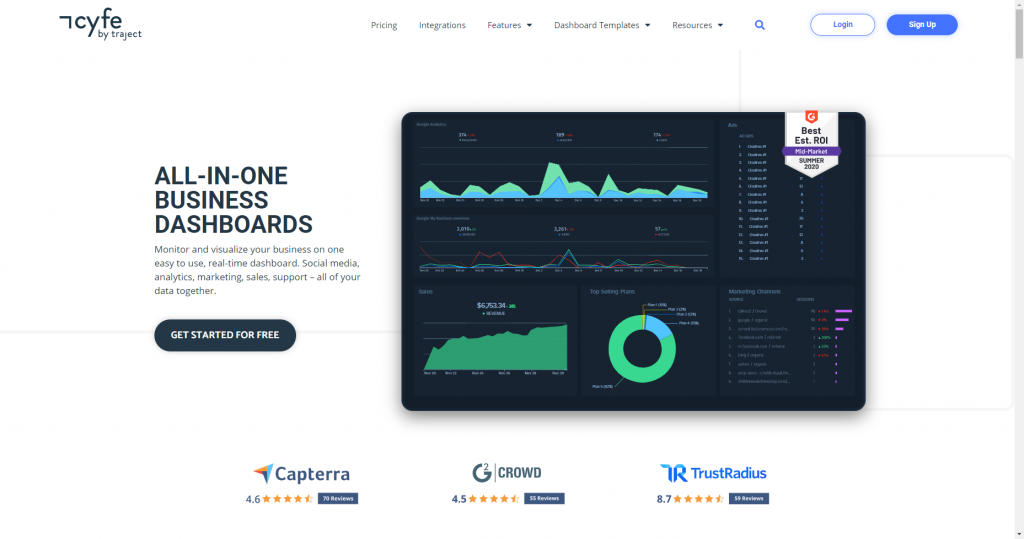Collecting data on your social media marketing performance is just the first step—you actually need to understand and use the data if you want to see any improvements. And, if you really want to boost the impact and return of your social media marketing strategy, you also need to measure your performance against your competitors.
A lot of brands aren’t super great at this process. They collect all this data about how their social media is performing, but they don’t know how to use that data to learn anything that will actually help them. They may even check out their competitors to see how they measure up next to them but since they don’t take steps to understand the information they’re receiving, nothing ever changes.
Understanding the social media benchmarks associated with your social media marketing strategy will help your brand put the data you’ve collected to use to refine your strategy and make real improvements.
You already know what your unique value proposition is but to communicate that in an increasingly crowded social media landscape you need to find the message that resonates with your target audience and cuts through the noise of your competition for deeper engagement, more qualified leads, and increased sales.
With this guide to social media benchmarks, you’ll know exactly what you should be measuring and how to use the data you collect to refine your social media marketing strategy for a better ROI.
A Complete Guide to Social Media Benchmarks to Refine Your Marketing Strategy:
What is Social Media Benchmarking?
Benchmarking simply means comparing your performance to industry standards, direct competitors, or your own historical performance. It helps you define what success looks like as well as define the metrics you’re going to use to evaluate and understand your current performance, predict future performance, and make improvements.
Social media benchmarking, then, is simply an evaluation of your current social media performance against industry standards, your competitors, and your own historical performance. Through social media benchmarking you can track and compare important social media metrics like engagement and reach, followers, and more.
Why Social Media Benchmarks Matter
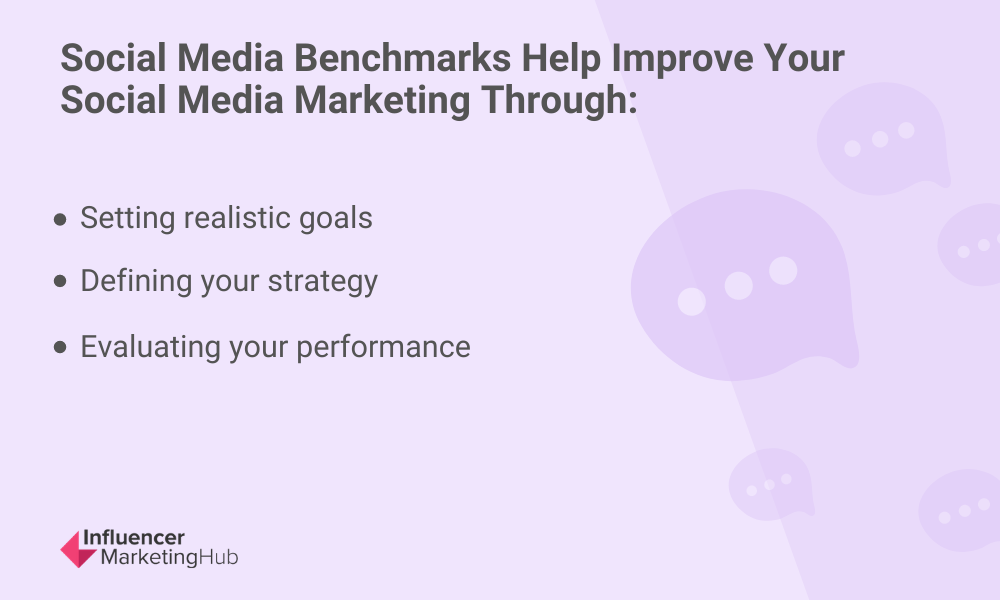
Tracking your performance through social media benchmarks is important to the success of your social media marketing campaigns. Without the use of social media benchmarks, brands are hard-pressed to know how they measure up to their competitors and, without this information, it’s hard (if not impossible) to adjust your marketing strategy in any meaningful way.
Performing benchmarking on a regular basis can have many benefits to your brand. First, it helps you improve your content strategy and focus on content that has an impact on your target audience. Since you and your competitors are marketing to the same people, using competitive analysis in your social media benchmarking process can help you find the parts of your message you need to improve.
On the other hand, if you continue operating without social media benchmarks, you’ll lack the clarity needed to develop a social media marketing strategy that works. It’s like firing a gun at a target in the dark—you know the target is there somewhere, but you’re going to waste a lot of time and energy trying to hit it.
Here are three key ways that social media benchmarks will help you improve your social media marketing.
1. Set Realistic Goals
When you have a thorough understanding of where you, your competitors, and your industry are in terms of performance, you get a much clearer picture of how you can use social media to improve your business. This will help you set goals that are realistic and based on social media benchmarks you can actually improve (because aiming for 5+ million followers when everyone else in your industry barely cracks 100K isn’t helpful or likely to happen).
2. Educate Your Strategy
Once you understand how your social media marketing campaigns are performing compared to your competitors or industry you can create a content strategy that builds on your strengths… and you’ll know that it’s data-driven.
3. Evaluate Your Performance
Social media benchmarks are exceedingly helpful when it comes to evaluating the performance of your marketing campaigns. There are several great things that come of this. For starters, you’ll gain more confidence in your marketing strategy, both because you’re seeing the improvements in your performance and because you’re able to make strategy decisions based on evidence. This also circles back to setting realistic goals since you’ll be able to evaluate your performance using the data you’ve collected and use that information to redefine or refine your goals.
How to Do Social Media Benchmarking

While there’s no single way to approach social media benchmarks and the process of benchmarking, we do have a seven-step process you can use to help you get started.
Step 1: Find Your Why
Before you can start measuring anything, you need to decide exactly what it is you’re measuring and why you need to do social media benchmarking. To do this, you need to start by analyzing your social media needs to identify what’s missing. Are engagement rates going to be your focus or do you need to take a look at your content strategy? Collecting and analyzing your data will help you choose the right steps to take with your social media marketing.
Step 2: Set Goals
Once you’ve decided what to focus on, it’s time to set goals. Measurable goals. If you run an eCommerce business and know your conversion rate, for instance, you might be interested in increasing traffic to your website since increasing the amount of traffic to your eCommerce site is likely to increase conversions. If you’re trying to increase brand affinity and build a community, your focus may be on engagement and increasing your number of followers. As you build out your social media benchmarking strategy, it’s important to tie everything back to the goals you set.
Step 3: Know Your Competitors
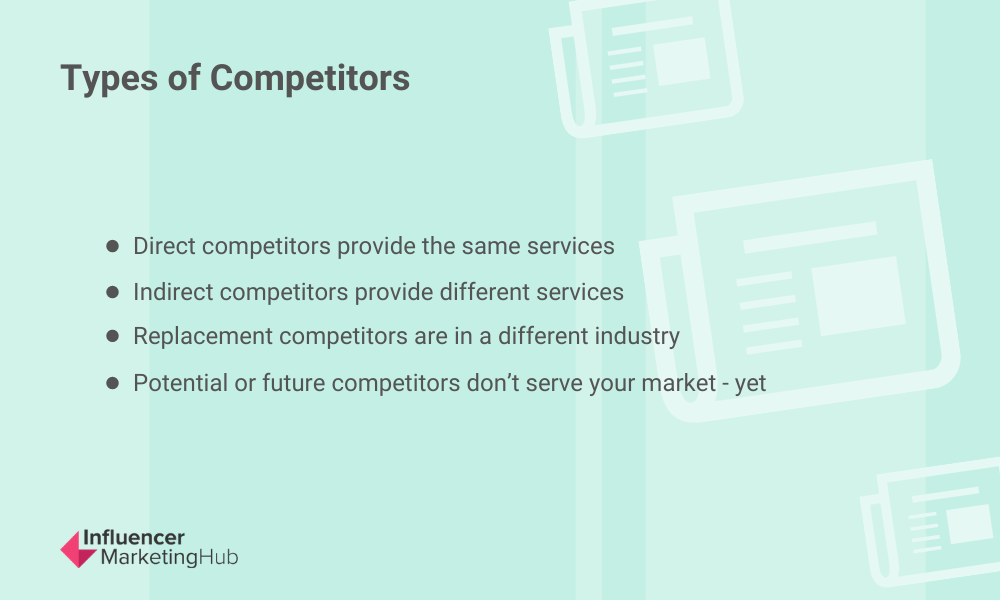
Since you presumably have a lot in common with your competitors, it’s important to stay on top of them and how they perform. You can do this with a competitive analysis. However, there are several different types of competitors to think about.
- Direct competitors are competitors that provide the same services you do for your same target market.
- Indirect competitors are those that provide different services but still compete in your market.
- Replacement competitors are competitors in a different industry but whose products could be a substitute for yours.
- Potential or future competitors are those that don’t serve your market currently but could in the future.
When you’re doing social media benchmarking you need to think about each of your competitors in terms of your own business goals. Think also about your future plans for your business as you’re benchmarking. If you have plans to scale your business, for instance, it makes sense to expand your definition of what counts as a competitor so your social media benchmarks align with your goals.
Step 4: Pick the Right Social Media Platforms
Now it’s time to decide what social media platforms you want to use for benchmarking. An important distinction to note here: you’re not deciding which social media platforms you’re going to use for social media marketing, you’re choosing the social media platforms you’re going to benchmark.
Refer to your competitor list and note the platforms your competitors are using. On which platforms are they seeing the most success? In addition to your competitors, you’ll want to think about your audience and the social media platforms they’re using.
Step 5: Choose the Right Social Media Metrics
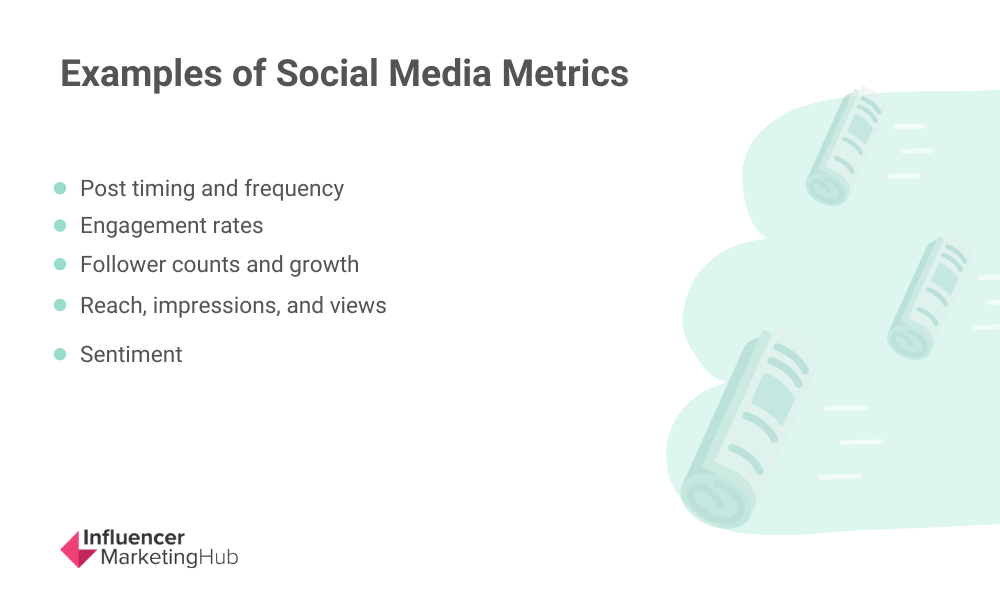
So far, you’ve set goals, gotten to know your competitors, and picked the social media platforms you’re going to use for benchmarking. Next, it’s time to choose the social media metrics that align with your business goals. You’ll likely find yourself bouncing back and forth between steps in this process, which is perfect. As you move through the steps, you’ll be learning more about your brand and your competitors, so it only makes sense that your strategy would change and evolve.
There are tons of social media metrics you can choose to track:
- Post timing and frequency
- Engagement rates
- Follower counts and growth
- Reach, impressions, and views
- Sentiment
- ...and more
For each metric you choose, you’ll need to decide how you want to track the metric and how you’ll decide if you’ve met your goals with that metric or not. For example, if you choose to track engagement, are you going to track total engagement, average engagement, or both? Identify and use the data that has the most impact on your social media strategy.
According to research by Socialinsider, here are the most important social media metrics as reported by hundreds of social media professionals:
- Engagement Rate per Post: 5 (61.4% of answers)
- Likes and Comments: 5 (48.7% of answers)
- Total Reach: 5 (43.7% of answers)
- Page/Follower Growth: 5 (42.4% of answers)
- Reach Rate per Post: 4 (40.5% of answers)
- Total Impressions: 3 (30.6% of answers)
- Impression Rate per Post: 3 (29.7% of answers)
So, what’s the difference between average and median? The average is calculated by adding up all the values of a specific metric and then dividing that total by the sum of the number of values. The median is the middle value in the list.
Step 6: Create and Document Actionable Insights
This is the place where many marketers drop the ball. It’s one thing to gather all of this information and data but it’s quite another thing to do something with it. Now that you have the information you need, it’s time to develop actionable insights from the data. Write down your findings from each of the previous steps and document your recommendations for your social media strategy.
Here are some examples of actionable insights:
- Our competitors get more reach from their Instagram posts but more engagement on their Facebook posts. We’ll focus on Instagram posts to increase brand awareness and use Facebook to drive traffic to our website.
- Video content in our industry has 3X the engagement rate of photos, so we should use at least one video each week on social media.
- Our competitor has the best Instagram engagement among our competitors. Their content is a mix of inspirational quotes, user-generated content, and videos, so we should start using these in our strategy.
The insights that you create should be closely related to your goals.
Step 7: Implement, Evaluate, and Adjust
The last step in this process is implementation, evaluation, and adjustment. Here’s where you put your insights into action. But, you can’t just stop there. To get the most from your social media benchmarks you need to continuously evaluate and adjust your actionable insights.
Social Media Benchmarks: Find the Right Tools
There are several social media benchmarking tools you can use to collect and organize the data you need for conducting a successful social media benchmarking. With so many tools, though, it can be hard to find the right one for your brand. Here are some things to look for when choosing the right social media analytics tool:
- Provides historical data about posts, engagement, growth, etc.
- Data is accurate.
- Provides in-depth reporting you can view monthly or quarterly (bonus points for automated reports)
- Data is collected using white-hat methods only.
Here are a few of the social media analytics tools we love:
Viralwoot
Viralwoot is a social media scheduler and analytics platform specifically for Pinterest. You can use it to create and schedule content without the need to go into your social accounts directly. Plus, you can use it to build relationships and engagement. Viralwoot includes an analytics section that shows your Pinterest success and provides an influencer score with suggestions that will help you improve your presence on Pinterest.
The software tracks data for all of your boards, including group boards, and makes it easy to monitor the number of followers, likes, pins, and repins. The data comes in a spreadsheet format so you can sort it easily.
Viralwoot helps you find the best days and times for you to post on Pinterest, tracks the SEO-friendliness of your boards, and even find the best colors to use in your content. With the SEO tools, you’ll get trending keywords from Pinterest so you can use them in your own content.
Quintly
Quintly provides more than 350 social media metrics you can use to measure your brand’s social media goals effectively. You can arrange your social media KPIs on the Quintly dashboard and either use a pre-built dashboard or create your own with just the information you want to see.
Cyfe
Cyfe offers an all-in-one business dashboard solution that lets users monitor social media, website analytics, marketing, sales, support, infrastructure, and more. It pulls data from a large number of services using pre-built widgets. These services include social sites, email collection sites, financial sites, WordPress, and others. Cyfe has eight central dashboards, one of which is related to social media. You get access to real-time data and metrics to track how your brand is performing across social media platforms and measure the ROI of your social media marketing efforts.
The Current State of Social Media

According to the 2020 Social Media Benchmark Industry Report from Rival IQ, here’s the bare minimum you need to know about the state of social media benchmarks:
Instagram Engagement Rates Decreased and Were Stagnant on Facebook and Twitter
For the first time in a while, Instagram saw a decrease in engagement while Facebook and Twitter maintained their 2019 engagement levels.
Posting Frequency Decreased
Brands posts slightly less often across social media platforms.
Giveaways Are Super Popular
Brands should look for opportunities to engage their followers with giveaways and online contests since contest and giveaway hashtags were popular across nearly all industries.
Instagram Carousels are Key
Carousel posts on Instagram lead to high engagement rates across all industries. Since carousels are re-delivered to users who don’t engage the first time, so brands should jump on opportunities to use them to get more impressions and more chances for engagement.
Use Social Media Benchmarks to Create a Strong Marketing Strategy
When you have a better understanding of your entire social media marketing strategy, you’ll know where to focus your energy to get better results. Add into the mix an understanding of your competitors, and you’ll have a solid foundation upon which to build. All of the social media benchmarks information we’ve included here can be applied to your brand, niche, and industry so you can create a social media marketing strategy that works for your brand and sets you apart from your competitors.
Social media benchmarking will help you find the data and information you need to improve your marketing performance. The framework we’ve provided can be reused and scaled to meet the needs of your brand.

